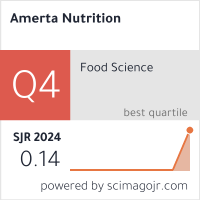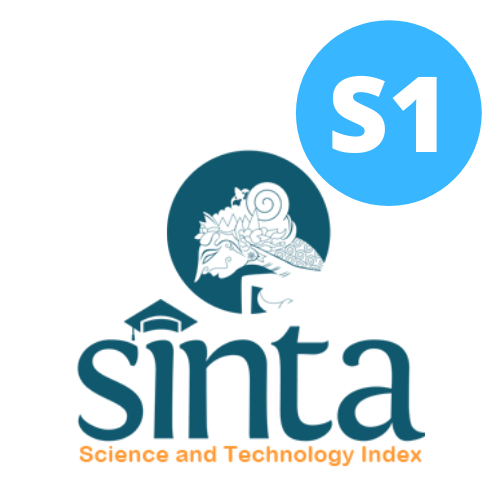Assessing the Predictive Accuracy of the Body Roundness Index for Prediabetes in Indonesian Adults
Analisis Prediksi Body Roundness Index untuk Prediabetes pada Orang Dewasa di Indonesia

Background: Anthropometric measurements for identifying body fat could be used to screen individuals with prediabetic risk.
Objectives: To evaluate and compare the diagnostic accuracy of body roundness index (BRI), conicity index (C-index), body mass index (BMI), waist circumference, and waist-to-height ratio (WHtR) as predictors of prediabetes in the adult population of Indonesia.
Methods: This study employs a cross-sectional design and uses secondary data from the Baseline Health Research (Ind: Riskesdas) 2018. As many as 12.327 samples were subjected to descriptive analysis, and the area under the curve (AUC) was utilised to assess the diagnostic potential of anthropometric measures in predicting prediabetes.
Results: The five anthropometric parameters have a very weak ability as a prediabetic predictor. The WHtR and BRI (AUCmen=0.571; AUCwomen=0.573) were significantly better than the other anthropometric parameters. In contrast, the C-index values for women (AUCwomen=0.548) were considerably lower than other anthropometric parameters. However, there was no significant difference between the C-index for men (AUCmen=0.560) and the waist circumference (AUC=0.564) and BMI (AUC=0.559) values.
Conclusions: The body roundness index has the same ability to predict prediabetes with WHtR, while the C-index in women is weaker than waist circumference and BMI.
International Diabetes Federation. IDF Diabetes Atlas. (Brussels, Belgium, 2021). doi:10.1016/j.diabres.2013.10.013.
Dall, T. M. et al. The Economic Burden of Elevated Blood Glucose Levels in 2012: Diagnosed and Undiagnosed Diabetes, Gestational Diabetes Mellitus, and Prediabetes. Diabetes Care 37, 3173 (2014). https://doi.org/10.2337/dc14-1036.
Dall, T. M. et al. The Economic Burden of Elevated Blood Glucose Levels in 2017: Diagnosed and Undiagnosed Diabetes, Gestational Diabetes Mellitus, and Prediabetes. Diabetes Care 42, 1661–1668 (2019). https://doi.org/10.2337/dc18-1226.
Y. Parmar, M. Obesity and Type 2 diabetes mellitus. Integative. Obesity and Diabetes 4, (2018). https://doi.org/10.15761/IOD.1000217.
Buss, J. Limitations of Body Mass Index to Assess Body Fat. Workplace Health & Safety 62, 264 (2014). https://doi.org/10.3928/21650799-20140514-04.
Ashwell, M., Gunn, P. & Gibson, S. Waist-to-Height Ratio is a Better Screening Tool than Waist Circumference and BMI for Adult Cardiometabolic Risk Factors: Systematic Review and Meta-Analysis. Obesity Reviews 13, 275–286 (2012). https://doi.org/10.1111/j.1467-789X.2011.00952.x.
Yoo Eun-Gyong. Waist-to-Height Ratio as a Screening Tool for Obesity and Cardiometabolic Risk. Korean Journal of Pediatrics 59, 426 (2016). https://doi.org/10.3345/kjp.2016.59.11.425.
Li, G. et al. The Feasibility of Two Anthropometric Indices to Identify Metabolic Syndrome, Insulin Resistance and Inflammatory Factors in Obese and Overweight Adults. Nutrition 57, 194–201 (2019). https://doi.org/10.1016/j.nut.2018.05.004.
Nkwana, M. R., Monyeki, K. D. & Lebelo, S. L. Body Roundness Index, A Body Shape Index, Conicity Index, and Their Association with Nutritional Status and Cardiovascular Risk Factors in South African Rural Young Adults. International Journal of Environmental Research and Public Health 18, 281 (2021). https://doi.org/10.3390/ijerph18010281.
Thomas, D. M. et al. Relationships between Body Roundness with Body Fat and Visceral Adipose Tissue Emerging from a New Geometrical Model. Obesity 21, 2264–2271 (2013). https://doi.org/10.1002/oby.20408.
Liu, Y. et al. Body Roundness Index is a Superior Obesity Index in Predicting Diabetes Risk Among Hypertensive Patients: A Prospective Cohort Study in China. Frontiers in Cardiovascular Medicine 8, 736073 (2021). https://doi.org/10.3389/fcvm.2021.736073.
Zhang, J., Zhu, W., Qiu, L., Huang, L. & Fang, L. Sex- and Age-Specific Optimal Anthropometric Indices as Screening Tools for Metabolic Syndrome in Chinese Adults. International Journal of Endocrinology 2018, 1067603 (2018). https://doi.org/10.1155/2018/1067603.
Wang, Z., He, S. & Chen, X. Capacity of Different Anthropometric Measures to Predict Diabetes in a Chinese Population in Southwest China: a 15-Year Prospective Study. Diabetic Medicine 36, 1261–67 (2019). https://doi.org/10.1111/dme.14055.
Dang, A. K. et al. Anthropometric Cut-Off Values for Detecting the Presence of Metabolic Syndrome and Its Multiple Components among Adults in Vietnam: The Role of Novel Indices. Nutrients 14, 4024 (2022). https://doi.org/10.3390/nu14194024.
Liu, X., Liu, Y., Guan, H., Feng, Y. & Kuang, J. Comparison of Six Anthropometric Measures in Discriminating Diabetes: A Cross-Sectional Study from the National Health and Nutrition Examination Survey. Journal of Diabetes 14, 465–475 (2022). https://doi.org/10.1111/1753-0407.13295.
Cho, S. et al. Optimal Cutoff Values for Anthropometric Indices of Obesity as Discriminators of Metabolic Abnormalities in Korea: Results from a Health Examinees Study. BMC Public Health 21, 459 (2021). https://doi.org/10.1186/s12889-021-10490-9.
Hernández-Vásquez, A. et al. Cut-off points of anthropometric markers associated with hypertension and diabetes in Peru: Demographic and Health Survey 2018. Public Health Nutrition 24, 611–621 (2021). https://doi.org/10.1017/S1368980020004036.
Valdez, R. A Simple Model-Based Index of Abdominal Adiposity. Journal of Clinical Epidemiology 44, 955–956 (1991). https://doi.org/10.1016/0895-4356(91)90059-I.
American Diabetes Association. Classification and Diagnosis of Diabetes: Standards of Medical Care in Diabetes - 2022. Diabetes Care 45, S22–S23 (2022). https://doi.org/10.2337/dc22-Sint.
Badan Penelitian dan Pengembangan Kesehatan. Laporan Nasional Riskesdas 2018. at (2019).
Dahlan, M. S. Penelitian Diagnostik, Validitas & Reliabilitas. (Epidemiologi Indonesia, Jakarta, 2018).
PGN. Peraturan Menteri Kesehatan Republik Indonesia Nomor 41 Tahun 2014 Tentang Pedoman Gizi Seimbang. (Kementeriann Kesehatan Republik Indonesia, Jakarta, 2014).
Al Mansour, M. A. The Prevalence and Risk Factors of Type 2 Diabetes Mellitus (DMT2) in a Semi-Urban Saudi Population. International Journal of Environmental Research and Public Health 17, 7 (2020). https://doi.org/10.3390/ijerph17010007.
Lee, P. G. & Halter, J. B. The Pathophysiology of Hyperglycemia in Older Adults: Clinical Considerations. Diabetes Care 40, 445–447 (2017). https://doi.org/10.2337/dc16-1732.
Andes, L. J., Cheng, Y. J., Rolka, D. B., Gregg, E. W. & Imperatore, G. Prevalence of Prediabetes Among Adolescents and Young Adults in the United States, 2005-2016. JAMA Pediatrics 174, e194498 (2020). https://doi.org/10.1001/jamapediatrics.2019.4498.
World Health Organization. Global Report on Diabetes. (WHO Press, Geneva, Switzerland, 2016).
Moradpour, F. et al. Prevalence of Prediabetes, Diabetes, Diabetes Awareness, Treatment, and its Socioeconomic Inequality in West of Iran. Scientific Reports 12, 17892 (2022). https://doi.org/10.1038/s41598-022-22779-9.
Siddiqui, S. Obesity and Diabetes: Interrelationship. Advances in Obesity, Weight Management & Control 8, 155–158 (2018). https://doi.org/10.15406/aowmc.2018.08.00233
Djap, H. S. et al. Waist to Height Ratio (0.5) as a Predictor for Prediabetes and Type 2 Diabetes in Indonesia. IOP Conference Series: Materials Science and Engineering 434, 012311 (2018). https://doi.org/10.1088/1757-899X/434/1/012311.
Chang, Y. et al. Body Shape Index and Body Roundness Index: Two New Body Indices to Identify Diabetes Mellitus among Rural Populations in Northeast China. BMC Public Health 15, 794 (2015). https://doi.org/10.1186/s12889-015-2150-2.
Alperet, D. J., Lim, W.-Y., Mok-Kwee Heng, D., Ma, S. & van Dam, R. M. Optimal Anthropometric Measures and Thresholds to Identify Undiagnosed Type 2 Diabetes in Three Major Asian Ethnic Groups. Obesity 24, 2185–2193 (2016). https://doi.org/10.1002/oby.21609.
Lee, J. J. et al. Visceral and Intrahepatic Fat are Associated with Cardiometabolic Risk Factors above Other Ectopic Fat Depots: The Framingham Heart Study. The American Journal of Medicine 131, 684–692 (2018). https://doi.org/10.1016/j.amjmed.2018.02.002.
Tramunt, B. et al. Sex differences in metabolic regulation and diabetes susceptibility. Diabetologia 63, 453–461 (2020). https://doi.org/10.1007/s00125-019-05040-3.
Schorr, M. et al. Sex Differences in Body Composition and Association with Cardiometabolic Risk. Biology of Sex Differences 9, 28 (2018). https://doi.org/10.1186/s13293-018-0189-3.
Yu, X.-Y., Song, P. & Zou, M.-H. Obesity Paradox and Smoking Gun: A Mystery of Statistical Confounding? Circulation Research 122, 1642–1644 (2018). https://doi.org/10.1161/CIRCRESAHA.118.312897.
Peraturan Menteri Kesehatan Republik Indonesia Nomor 2 Tahun 2020 Tentang Standar Antropometri Anak. (Indonesia, 2020).
Power, M., Fell, G. & Wright, M. Principles for High-Quality, High-Value Testing. BMJ Evidence-Based Medicine 18, 5–10 (2013). https://doi.org/10.1136/eb-2012-100645.
Copyright (c) 2025 Amerta Nutrition

This work is licensed under a Creative Commons Attribution-ShareAlike 4.0 International License.
AMERTA NUTR by Unair is licensed under a Creative Commons Attribution-ShareAlike 4.0 International License.
1. The journal allows the author to hold the copyright of the article without restrictions.
2. The journal allows the author(s) to retain publishing rights without restrictions
3. The legal formal aspect of journal publication accessibility refers to Creative Commons Attribution Share-Alike (CC BY-SA).
4. The Creative Commons Attribution Share-Alike (CC BY-SA) license allows re-distribution and re-use of a licensed work on the conditions that the creator is appropriately credited and that any derivative work is made available under "the same, similar or a compatible license”. Other than the conditions mentioned above, the editorial board is not responsible for copyright violation.












































